In this post we will explore double pointed knitting needles. These are also known as DPN and come in sets of 4 or 5 needles. They also come in 15cm (6in), 20cm (8in) and even 30cm (12in) and 40cm (15in) for larger projects such as adult sweaters!
DPNs are really useful when it comes to knitting things in the round. They are incredibly handy when knitting something small like the finger of a glove, or a baby sleeve.
Knitting with double pointed knitting needles can look really complicated, but once you realise you’re only ever knitting with two needles at a time you will be able to knit in the round easily with these handy sets of needles.
In this article, we will be looking at:
- How to cast on with double pointed knitting needles (video or step by step photo tutorial)
- What kind of needles you will need for your project.
- How to choose your next set of double pointed knitting needles.
Find out more about double pointed knitting needles below.
Disclosure: This post may contain affiliate links. This means that if you choose to shop via any of the links, I will receive a small commission at no extra cost to you.
Here’s how to cast on and knit with double pointed knitting needles.
Ever wanted to try double pointed needles but were put off by how complicated they look? Maybe after seeing how to cast on and knit with them, you might see past the entangled hedgehog and feel more confident about giving them a try.
Here’s a video showing you how to knit with double pointed needles. There is also a step by step photo tutorial on this page.
What are double pointed needles used for?
You can use DPNs (double pointed needles) to knit absolutely anything in the round. You can use short ones such as 10cm and 15cm to knit socks and mittens, then there’s 20cm needles for hats and cowls. There are also 40cm double pointed needles to knit garments on. They’re very versatile and knitters have been using them for at least a century. That’s a long enougn lifespan to justify their usefulness, don’t you think?
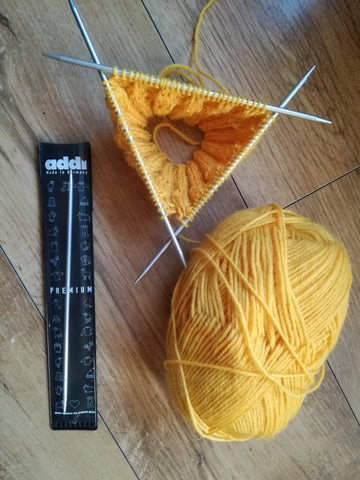
Double pointed needles come in a range of materials and textures too. Wood needles are probably the lightest, with aluminium, plastic and steel not far behind. You can try the different materials out and see what’s right for you. Wood needles have a bit more flex so can therefore be more forgiving for a loose-tensioned hand. The steel needles may be more slippery and less useful for you but you won’t know until you try them as they can have excellent precision on lace knitting and picking up stitches.
This blog post is all about getting you started with double pointed needles. Take your time, be patient and have a go!
Casting on with double pointed needles:
To cast on, cast on like you would with a traditional, straight needle. A problem for many beginners is casting on too tightly and this can cause your stitches to twist, so here’s what I do:
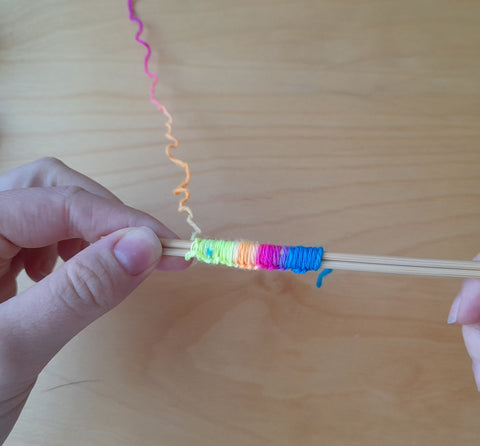
Cast on across two needles held together. This forces some space between the stitches and allows you to easily get the next needle into the stitches. If your cast on method doesn’t work with this two needle technique, just cast on with one larger, straight needle.
For the sake of this tutorial, let’s call them needle 1, 2 and 3 with an active needle.
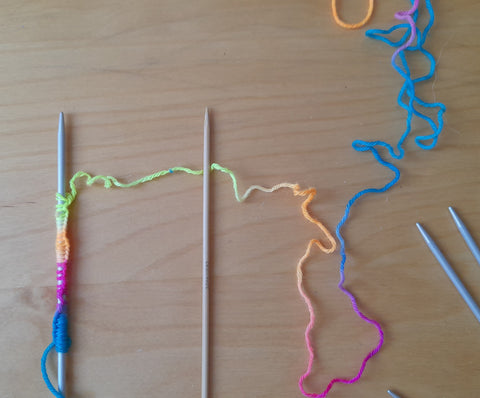
In this example here I have a 4mm straight needle to cast on with and I’m using 3mm double pointed needles for the rest of the project. This needle with no stitches on it will be needle 1.

When you have cast on the desired amount of stitches, use just one of the spare needles to start knitting. Let’s say that in this example it is a sock that we are knitting, we would be doing rib stitches (K1, P1).
Decide how many needles you want to use to knit your project.
Double pointed needles come in sets of 4 or 5. Most knitters will use 3 or 4 needles to hold stitches and 1 needle as the active needle.
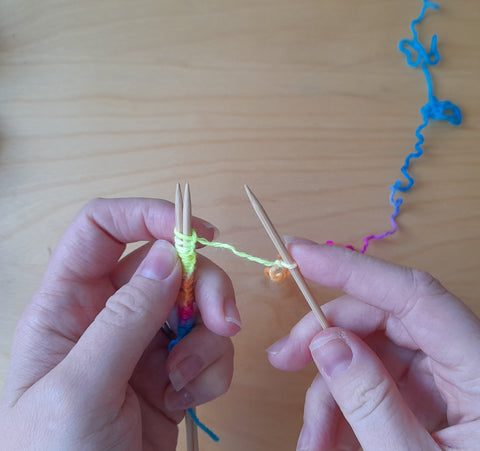
In this example, I’m knitting stitches using the active needle. This will become needle 1. I’ve called it the ‘active’ needle and as you knit in the round, there should always be one free or ‘active’ needle for picking up the stitches.
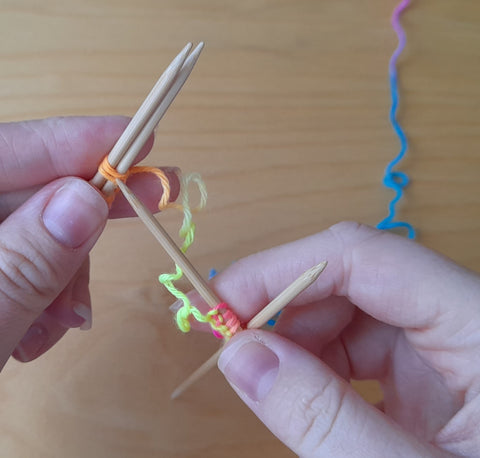
Now I’m knitting another batch of stitches onto the active needle. This will be needle 2.
When you’ve decided how many stitches you need to have on each of the needles, just keep knitting across them with the active needle. The active needle will change every time you finish a set of stitches. In the photo above, I’m knitting the second set of stitches with my active needle.

If you’ve cast on over two needles, you can remove one of them when knitting the last set of stitches as you’ll need a new active needle to create needle 3.
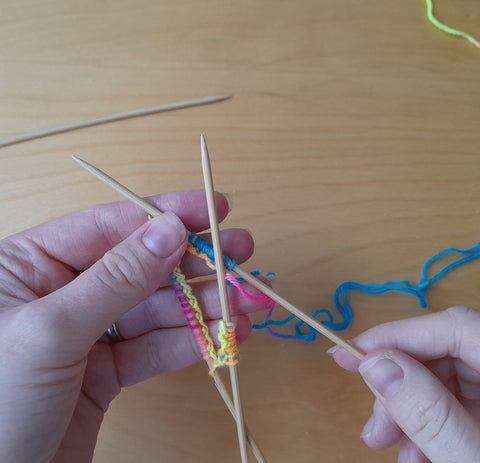
When you’ve knit across all of the cast on stitches, it is time to join to work in the round. All you have to do is bring the first needle back to your right hand. It should have the tail end with it. I’ve knit across needle 1, 2 and 3 and have an active needle (4th needle). You can do this easily by flipping the entire project over.

To join, knit the first stitch of needle 3 with the active needle.
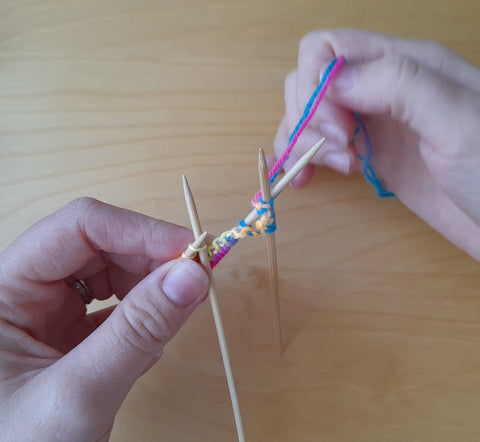
This will cause them to join in the round. You just keep knitting across the needles until you get to the desired length.
If you’re knitting something larger like a hat or even a garment, you may want to use 4 needles plus the active needle.
How do I stop the needles slipping off?
If you are starting out and don’t feel confident keeping control of the needles, this can be due to loose tension/things getting caught,
To ensure the needles don’t point vertically and slip out of your stitches, you can try any of these things:
- Knit over a desk so that the needles stay mostly horizontal.
- Knit over a cushion on your lap. This will stop the needles from dropping anywhere.
- Make sure your sleeves aren’t long and getting in the way. Roll them up or wear short sleeves when you’re using your DPNs for the first few times.
- Try not to hold the needles up to your face to see stitches. This can cause them to slip off. Make sure you have good lighting and can see the project well.
- Use needle stoppers. These are usually rubber shapes such as cones or balls that stop stitches slipping off the needles. Whilst they are very practical for needle storage and holding projects when you’re not using them, they might be a bit of a hassle if you have to remove them every time you knit onto the next needle.
As your tension improves, your needles should stay on the stitches.
Using double pointed needles shouldn’t be scary
At the end of the day, you are only ever knitting with two needles at any one time. Don’t let other knitters put you off using double pointed needles. There are often well meaning but unhelpful suggestions to “just use magic loop” or “buy these types instead” but I think it’s important that you try things out before deciding what is and isn’t for you. For all you know, you could love using double pointed needles.
Which DPNs are right for me?
There are many types of knitting needles due to personal preference. Some knitters prefer lightweight, wood needles while others prefer metals like steel and aluminium. Generally, plastic and aluminium are at the cheaper end of the range available, but they’re great to have if you’re just learning! Take a look at these types below to see what you would prefer when it comes to knitting with double pointed needles.
Lykke Driftwood Double Pointed Knitting Needles (6in)
Many knitters swear by LYKKE needles and it’s simple to understand why: they’re lightweight and available in natural materials. These driftwood needles are 16 Sizes (2mm – 9mm).

Lykke is the Norwegian word for happiness, which is certainly what you’ll be feeling by using their range of knitting and crochet accessories.
As global demand is increasing for our products, this community of skilled workers is growing too, expanding our output capacity. High quality materials and thoughtful design details produce the most beautiful and durable products. The craftsmanship is really something to admire! All knitting needles and crochet hooks are handcrafted and assembled in Nepal by Nepalese craftspeople.
These needles are renowned for their reputation of being strong and flexible with a smoothness that won’t snag! Buy now and add something special to your craft bag.
Addi bamboo double pointed knitting needles.
These little needles are so smooth and lightweight. I used them in some of the images above, as well as the video. This is because I was knitting something really small (a mini sock) and didn’t want long, heavy needles getting stuck on the desk as I worked. The addi bamboo double pointed knitting needles are small as well as light, so they’re really handy for on-the-go knitting or working with something tiny, like a toy!
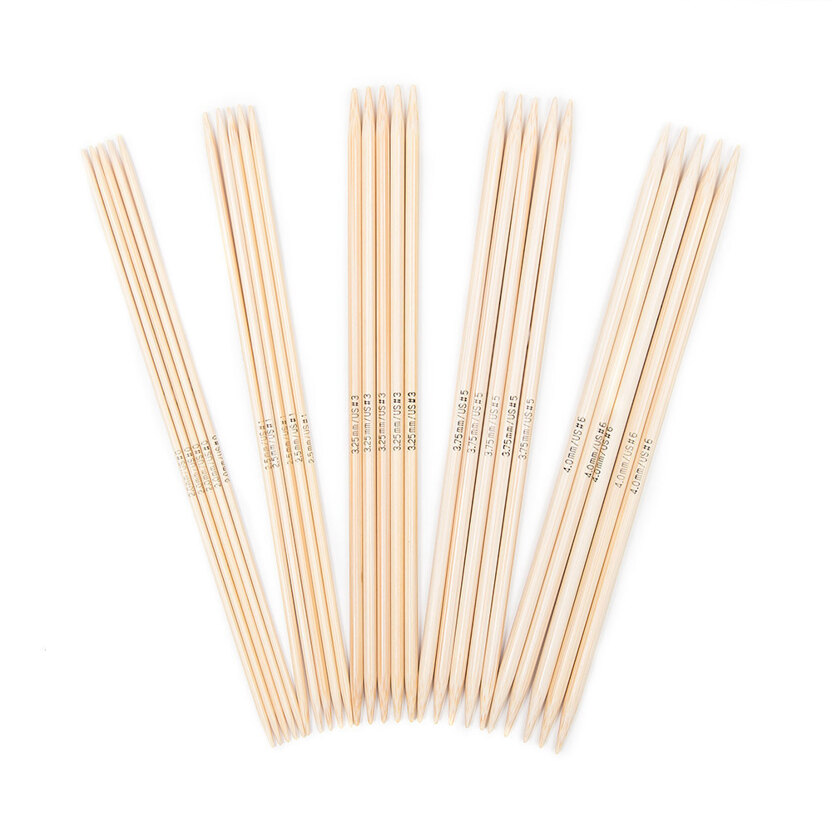
What I particularly like about these needles is how smooth they are. They’re waxed, so they don’t splinter easily and the yarn glides down the shaft just as it would with a metal needle. I would suggest using bamboo knitting needles for acrylic yarns as the plastic on plastic you get with Pony needles for example can be quite squeaky! Not ideal if you’re sensitive to that kind of thing.
They’re also getting my vote because they come in 6 handy sizes. Start really small with 2mm and work your way up to 4mm. They’re absolutely perfect for tiny things like toys, socks and gloves.
Addi grey aluminium double pointed knitting needles
These double pointed needles are my absolute favourite, ever. They’re a great size for socks and mitts as well as sleeves. I swear these needles make me knit faster! They’re so simple and in the years I’ve owned addi aluminium needles, none have bent. I’ve had my longer straight needles kink, and my thinner knitpro needles bend, but not these. My addi’s have been loyal to me and are fantastic for knitting sleeves for my kids’ stuff as well as for my own. I think the 20cm length are perfect for sleeves and hats as once you’ve separated the stitches, they don’t go riding off the edge easily.

They’re smooth, coated metal so there’s no snagging or pulling on your stitches. I wouldn’t recommend them if your hands are sensitive to the cold (the bamboo or driftwood needles are better suited in this department) but they’re great and they’re still my favourite. As with most needles, they come in several sizes so they’ll suit a variety of projects. They come as a set of 5 so you can always leave that extra one in the bag if you’re not knitting a big hat or an adult sleeve. I have these in sizes 3.5-5.5mm because I find them so handy. You can shop Lovecrafts range of addi double pointed knitting needles here.
Other double pointed knitting needles to consider:
Personally, I love anything by addi. They’re always such fun designs and so very useful. Being German, they scream practicality and functionality, but there’s also some cuteness there. I just love these needles. You can see Lovecrafts’ range of DPNs available here.
Thank you for reading!
